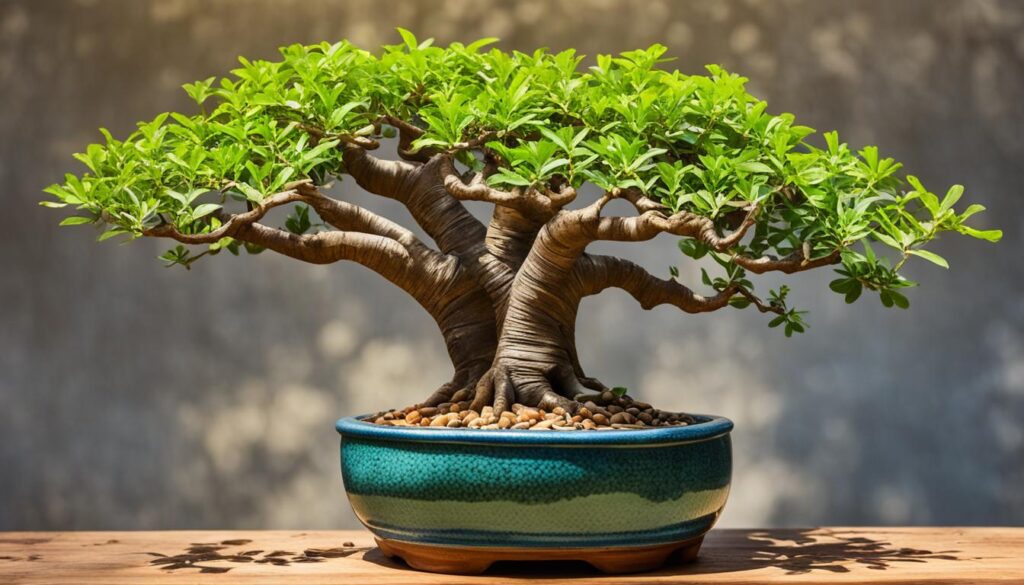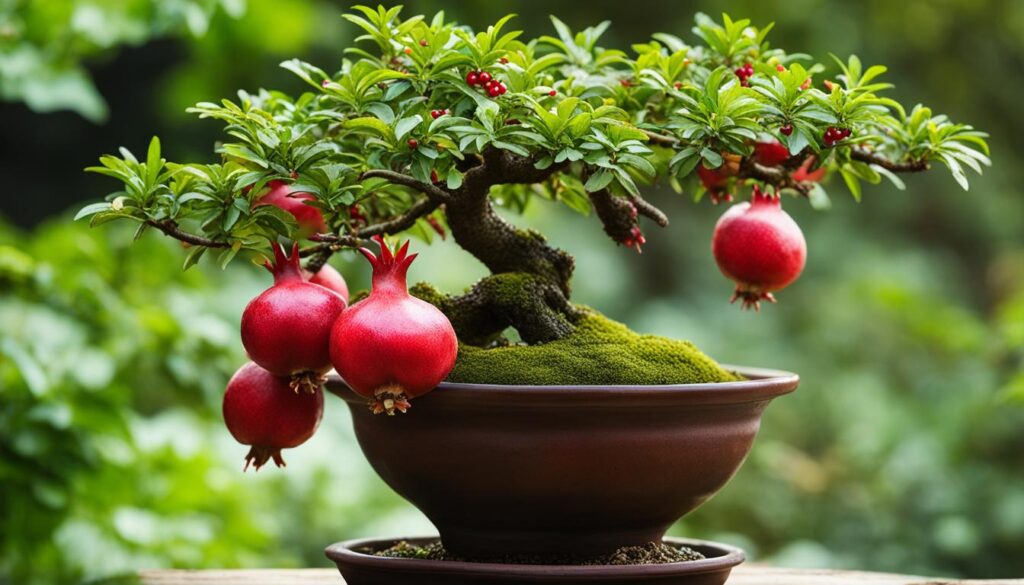Welcome to our care guide for the Fukien Tea Bonsai Tree, also known as Carmona retusa. This guide offers vital information for bonsai enthusiasts and beginners alike. You will find tips on bonsai care, pruning techniques, Fukien tea bonsai care, and designing bonsai trees. Let’s explore the beautiful Fukien Tea Bonsai Tree.
Fukien Tea Bonsai Tree Environment
The Fukien Tea Bonsai Tree is a subtropical evergreen shrub from East and Southeast Asia. It grows best at 70°F (20°C). While it is primarily an indoor bonsai, it can also thrive outdoors in warm climates. This section outlines the environmental needs for the Fukien Tea Bonsai Tree and how to create suitable conditions.
Optimal Placement for Your Fukien Tea Bonsai Tree
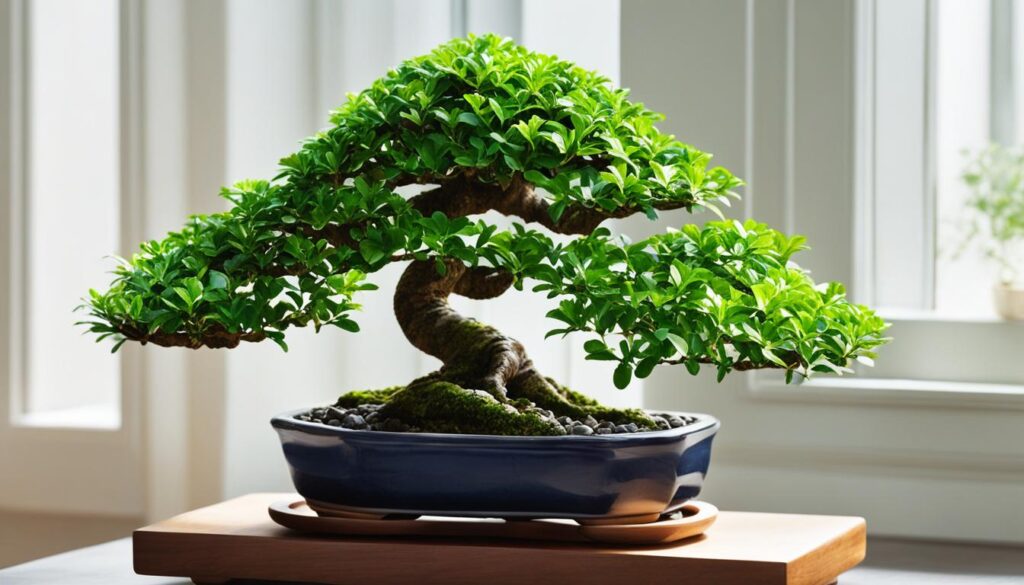
Indoor Positioning for Year-Round Beauty
Proper placement is key for your Fukien Tea Bonsai Tree’s health and beauty. It thrives in bright, indirect light. Place your bonsai tree near a window with eastern or western exposure. Avoid direct sunlight to prevent leaf burn.
Adapting to seasonal changes is also vital. Adjust the placement of your bonsai as daylight hours change. In winter, supplement lighting with grow lights if necessary.
Maintain temperatures around 70°F (20°C). Keep your bonsai away from drafts and extreme temperature changes. Stable temperatures help your bonsai thrive.
Adapting to Seasonal Changes
Adapting to seasonal changes is important for your Fukien Tea Bonsai Tree’s care. Move your tree outdoors in warm months for sunlight and fresh air. Ensure the temperature remains within range.
As autumn approaches, gradually acclimate your tree to indoor conditions. Reduce direct sunlight exposure and adjust your watering schedule.
In winter, provide a cooler environment around 60-65°F (15-18°C). Reduce watering frequency as the tree needs less moisture during dormancy.
Ensuring Adequate Lighting and Temperature
In addition to indoor positioning and seasonal adjustments, ensure adequate lighting and temperature year-round.
Fukien Tea Bonsai Trees thrive in bright, indirect light. Use curtains to filter intense sunlight. If natural light is low, use grow lights.
Maintain temperatures around 70°F (20°C). Avoid extreme fluctuations that can stress your bonsai. Use a thermometer to monitor temperature and adjust as necessary.
Providing optimal lighting and stable temperatures will help your Fukien Tea Bonsai Tree thrive.
Watering Your Fukien Tea Bonsai Tree
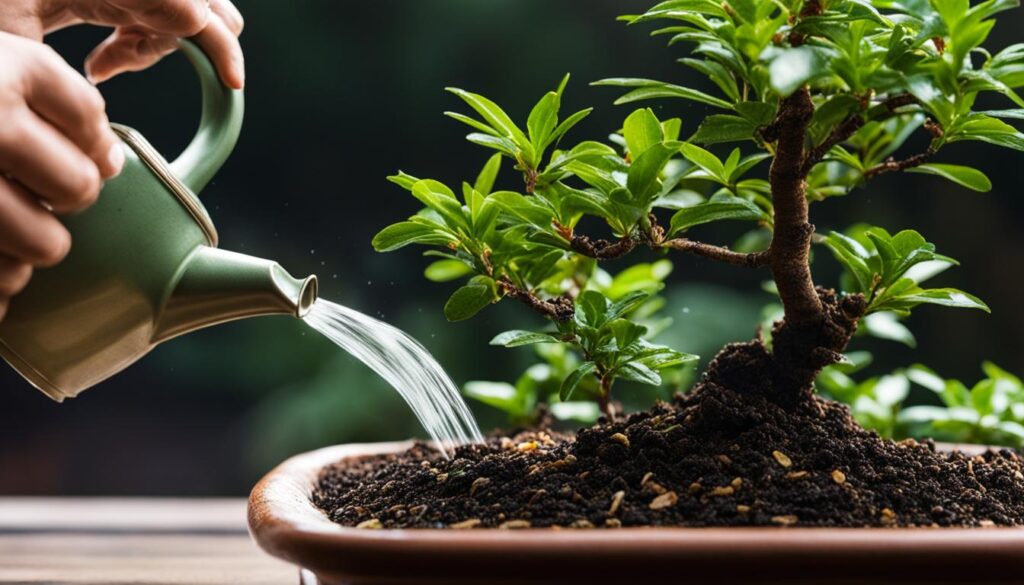
Proper watering is crucial for the health of your Fukien Tea Bonsai Tree. It is important to balance between underwatering and overwatering.
To determine when to water, check the soil moisture. Your bonsai prefers slightly moist soil. If the top inch of soil feels dry, it is time to water.
The frequency of watering varies based on tree size, pot size, and environmental conditions. Water when the top layer of soil feels dry.
Here are some watering techniques:
- Water slowly and evenly to reach all parts of the root system.
- Use a watering can with a fine nozzle or a watering wand for gentle distribution.
- Avoid using chlorinated or hard water. Use filtered or distilled water if possible.
- Adjust your watering schedule based on weather conditions. Water more often in hot months.
Monitor your Fukien Tea Bonsai Tree for signs of overwatering or underwatering. Overwatering signs include yellowing leaves and mold growth. Underwatering signs include wilting leaves and dry soil.
By following these watering techniques, you can ensure the health of your Fukien Tea Bonsai Tree.
Fertilizing the Fukien Tea Bonsai Tree
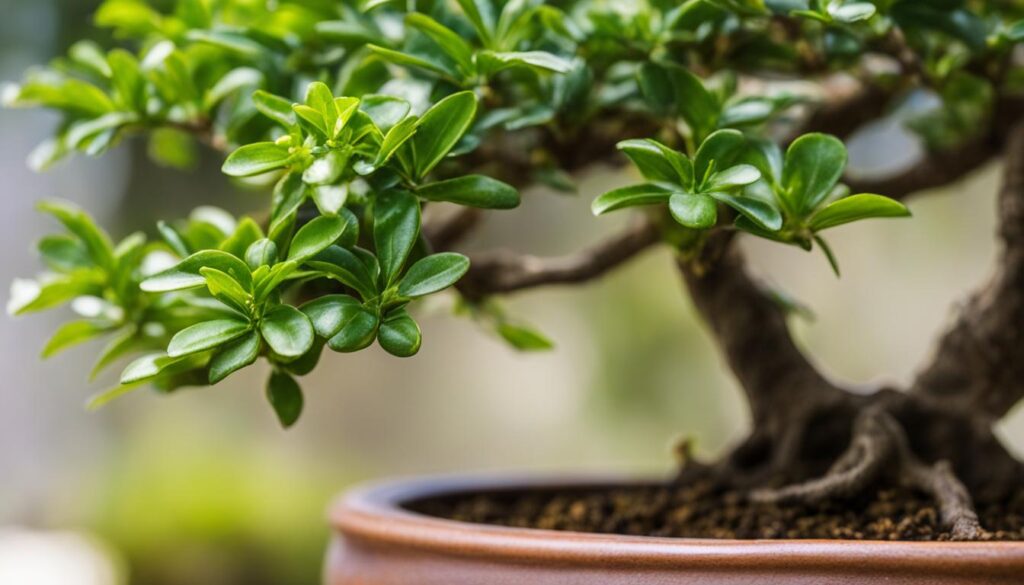
Fertilizing your Fukien Tea Bonsai Tree is essential for healthy growth. The right nutrients help promote vibrant foliage and overall tree vitality. This section discusses selecting the right fertilizer and the frequency of fertilization.
Choosing the Right Fertilizer
Select a balanced fertilizer with nitrogen, phosphorus, and potassium (N-P-K) in appropriate ratios. Nitrogen promotes leaf growth, phosphorus supports root development, and potassium enhances tree health.
Use slow-release or organic fertilizers. These provide nutrients gradually and prevent overfeeding. Organic fertilizers also enrich the soil with beneficial microorganisms.
Fertilization Frequency Through the Seasons
Fertilize your Fukien Tea Bonsai Tree every two to four weeks in the growing season (spring to early autumn). This provides essential nutrients for active growth.
In winter, reduce fertilization to once every four to eight weeks. The tree’s activity slows, and excessive fertilization can cause nutrient stress.
Follow the instructions on the fertilizer package and avoid over-fertilizing. Monitor your bonsai’s growth and adjust the schedule as needed.
Pruning and Wiring Techniques for Fukien Tea Bonsai Tree
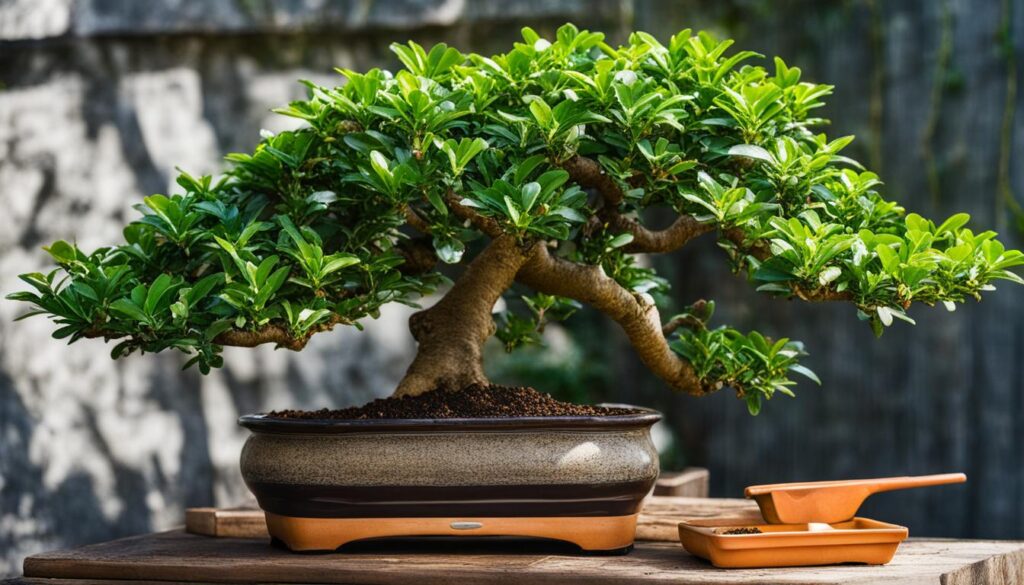
Pruning and wiring help maintain the shape and health of your Fukien Tea Bonsai Tree. Proper pruning promotes branching and denser foliage, while wiring helps shape the branches.
Prune during the warmer months, ideally in late spring or early summer. Use sharp bonsai scissors for clean cuts. Remove any dead, damaged, or overgrown branches. Selectively prune healthy branches to encourage back-budding.
Wiring allows you to shape the branches of your bonsai. Ensure the branches are flexible before wiring. Use aluminum or copper bonsai wire, selecting the right thickness for the branch size. Wrap the wire gently around the branch and guide it into position.
Monitor wired branches to avoid the wire cutting into the bark. Remove the wire carefully after a few months to prevent damage. Always prune and wire with caution to maintain tree health.
How to Properly Repot the Fukien Tea Bonsai Tree
Repotting ensures the proper growth of your Fukien Tea Bonsai Tree. Understand when to repot, choose the right soil mixture, and care for the roots during the process.
When to Repot Your Bonsai
Repot your Fukien Tea Bonsai Tree when it outgrows its pot or when the soil becomes compacted. Repotting should occur every two to three years, preferably in early spring.
Choosing Soil Mixture and Root Care During Repotting
Select a well-draining soil mixture that retains moisture. A mix of organic matter like peat moss and inorganic components like perlite works well.
Carefully remove your bonsai from its pot, pruning overcrowded or damaged roots. Place the bonsai in a new pot with fresh soil, spreading the roots evenly. Pack the soil around the roots for stability.
Water the bonsai thoroughly after repotting and place it in a shaded area for recovery.
Propagation Methods for the Fukien Tea Bonsai Tree
Propagation allows you to expand your bonsai collection. Here are two popular methods: using seeds and taking cuttings.
- Seeds: Collect and grow bonsai seeds by waiting for the tree to produce fruit. Harvest the ripe seeds and plant them in well-draining bonsai soil at a depth of half an inch. Keep the soil moist and in a warm, well-lit area.
- Cuttings: Take cuttings from healthy branches. Make a clean cut below a leaf node and dip it in rooting hormone. Plant the cutting in a well-draining soil mixture and keep it moist. Provide humidity by covering the cutting with a plastic bag or using a propagating box.
Note: Propagation requires patience. New plants may take months or years to mature. The satisfaction of nurturing your own bonsai trees is rewarding.
Maintaining Health: Pests and Diseases of the Fukien Tea Bonsai Tree
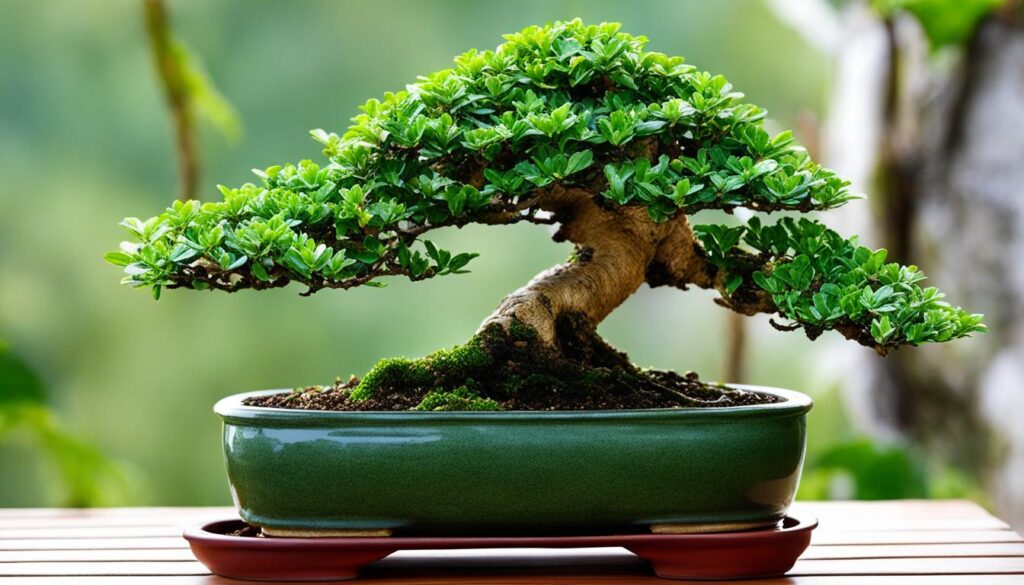
The Fukien Tea Bonsai Tree is prone to pests and diseases. Being aware of these threats helps maintain its health.
Common Pests:
- Aphids: Small insects that can cause yellowing leaves. Control them with insecticidal soap or water sprays.
- Spider mites: Tiny pests causing leaf discoloration. Keep humidity high to prevent infestations.
- Scale insects: Attach to stems and leaves, feeding on sap. Use a cotton swab with rubbing alcohol to remove them.
Common Diseases:
- Root rot: Caused by overwatering or poor drainage. Use well-draining soil and adjust watering practices.
- Powdery mildew: Appears as a white coating on leaves. Prune affected leaves and improve air circulation.
- Leaf spot: Characterized by dark spots on leaves. Remove infected leaves and avoid overhead watering.
Crafting the Aesthetics: Styling the Fukien Tea Bonsai Tree
Styling your Fukien Tea Bonsai Tree is a creative way to express your artistic vision. Selecting a bonsai style that complements its characteristics enhances its beauty.
Choosing a Bonsai Style that Complements the Carmona Retusa
Consider the tree’s foliage, trunk shape, and growth pattern when choosing a bonsai style. Popular styles for the Carmona Retusa include formal upright, informal upright, and cascading. Each style highlights different features of the tree.
Wiring and Reshaping Tips for Designing Your Bonsai
Wiring and reshaping are vital techniques in bonsai styling. Ensure your bonsai tree is healthy before wiring. Wrap wire around branches carefully, guiding them into the desired position.
During the reshaping process, maintain harmony between the trunk, branches, foliage, and pot. Prune excessive growth to keep the desired shape and remove dead branches regularly. Combining wiring and reshaping creates a captivating bonsai tree.
Explore the Guide for Thriving Black Pine Bonsai! >>>
Discover the Comprehensive Care Guide for Bonsai Carmona Microphylla! >>>

